陕旅版六年级上册Unit 5教案
陕旅版2020学年小学英语六年级上册:单元教案unit5____第1课时教学设计

Unit5 第1课时教学设计教学目标1. 能听、说、读、写词汇:scarf, wallet, sunglasses, gloves, warm jacket, rain boots, school bag。
2. 能在实际生活中灵活运用以上词汇。
教学准备教师准备:(1) Let’s learn部分的教学卡片、雨衣图片及一些表示天气的图片。
(2) Let’s learn部分的音频。
(3) 一个书包,书包里装有Let’s learn部分所学词汇对应的实物。
(4) Ask and answer部分的词汇卡片。
教学方法建议I. 课程导入(Leading In)1. 课前热身Part A Warming-up: Look and chooseT: Hello, boys and girls. Nice to see you again. How is the weather today?S: It’s sunny / cloudy / rainy.T: Great. Now please open your books and look at the exercise on Page 37.教师让学生观察每幅图片,通过问答引导学生说出图中所示的天气,并要求学生给图片选出相匹配的单词。
以下问答仅供参考:T: Look at the first picture carefully. What can you see?Ss: Clouds and rain.T: What’s the weather like, then?Ss: It’s rainy.参考答案:c, b, a, e, d .2. 新课导入教师引导学生就天气话题继续讨论:T: What kind of weather do you like?Ss: I like...T: I like sunny days. On sunny days, the weather is fine. The sun is bright. But it’s very hot. Now, look! I’m wearing my T-shirt. Do you feel hot, S1?S1:…II. 课程展示活动和过程的设计建议(Presentation)1. 新课展示Part A Let’s learn1. 学习单词sunglasses(1) 教师戴上自己的太阳镜,与学生进行对话:T: It’s a sunny day. I am wearing my sunglasses. Look! They are dark. I think I am very cool. But do I need to wear them in the classroom?Ss: No.T: I have had eyesight. I should wear glasses. I have a pair of glasses. What color are they?Ss: They are blue/ red.(2) 小调查:Who is wearing glasses?教师请学生就班里戴眼镜的同学进行调查,并请学生用长句子回答。
陕旅版六年级英语上册教案5篇

陕旅版六年级英语上册教案5篇陕旅版六年级英语上册教案5篇在课程改革的今天,我们要改变的是教案的模式化,只备“课”不备“人”,只备“形”不备“神”,只备结果,不备过程,教师的教案充其量只是教师的“备忘录”。
下面小编给大家带来关于陕旅版六年级英语上册教案,方便大家学习陕旅版六年级英语上册教案1教学目标:1能听懂会认会读并识别Physics Chemistry History Geography等单词。
2能运用I m going to study___. 等语句来介绍将来的中学生活。
重点难点:1能听懂会认会读并识别Physics Chemistry History Geography等单词。
2能运用I m going to study___. 等语句来介绍将来的中学生活。
教学过程:Step 1:Warm-up and show the learning aimsT: My kids, yesterday we learnt Sam is going to go to middle school, and he is going to study physic chemistry, history . Today let talk about what are you going to study? (板书课题并齐读) First ,please look at our learning aims.(出示本课学习目标,教师慢慢读,学生仔细看认真听。
)Step 2: Show the guides (指导自学)1Review some words about subjects Chemistry ,Math ,history Chinese… 2T: Look at here. She is lily and he is Peter. We ll watch a video about them. Before watching the video, let s see three tasks.(1)Look at the pictures and read the text(2)Listen to the tape and read each sentence.(3)Students read the sentences and the new words. Then talk each other 3Talk to a friend. What are you going to study? Choose and draw threesubjects.4Memory game: How are you going to go to school?Step 3: PracticeAsk and answerWhere are you going to study?What are you going to study?板书设计:Unit 2 What are you going to study?A: what are you going to study?B: I am going to study Chinese, Math History, and Chemistry陕旅版六年级英语上册教案2《my home》教材分析:本课时主要是通过展示家庭居室结构,让学生学习各个房间的英文名称study, bathroom, bedroom, living room, kitchen. 家是每个学生最熟悉的地方,学生要学会运用本课所学知识来简单描述自己的家,结合学过的语言描述各个房间。
陕旅版六年级上册全册教案

PartA
课时
第3~4课时
教
学
目
标
1.学说第2页课文对话,做到能听说认读。
2.能掌握一般过去时的一般疑问句和特殊疑问句的几种人称表达方法
3.能替换关键词进行主要句型的对话练习
知识重点
学说第2页课文对话,做到能听说认读。
知识难点
能掌握一般过去时的一般疑问句和特殊疑问句的几种人称表达方法
教学用具
磁带,单词图片,课件
5.Listen to the tape and repeat.
6.Practice the dialogue.
Step 3 Practice
Game---Chain game
Step 4 Consolidation
1.Make a small survey.
2.Give assessment
课后反思
教学内容
个性化修改
Step 1 Warming up
1欣赏英文歌曲。
2了解单元大概内容。
Step 2.Revision&Presentation
1.Show pictures of scenery or photos, pin them on a blank paper)
T: Hello, boys and girls. I like traveling very much. I’ve been to many places, for example, Shanghai, Beijing, Guangzhou…...They are all beautiful places. I took many pictures.
another 另一个
poster海报
六年级英语上册Unit5ItWasHereJustNow(第4课时)教学设计陕旅版(三起)

六年级英语上册Unit5ItWasHereJustNow(第4课时)教学设计陕旅版(三起)教学目标1. 复习和巩固一般过去时中be动词was,were的用法。
2. 复习和巩固物品过去和现在的位置的表达。
教学准备教师准备:Listen and match部分的音频。
教学方法建议I. 课程导入(Leading In)1. 课前热身根据上节课所学的对话,课前热身建议如下:T: From the dialogue, we know Liu Zhaoyang’s father was at the same school thirty years ago. At that time, the school was small. There was a small library. And there were about six hundred students in the school. But now, there are about two thousand. It is a big school. How many students are there in our school, do you know?2. 新课导入根据本单元内容,教师可设计一些类似下面这样的会话作为导入活动:T: Where is your English book?S1: It is on my desk.T: Was it on the desk an hour ago?S1: No.T: Where was it?S1: It was in my school bag.T: Was there a Chinese book in your school bag, too?S1: Yes, there was.(教师引导学生说) And there were many other books in it.T: I see. Now please open your books. What shall we do today? We have many things to do. II. 课程展示活动和过程的设计建议(Presentation)1. Part C Listen and match1. 教师引导学生观察上面一排的图片,以What’s this / that? What is it? 提问,让学生说出场所名称。
陕西旅游版六年级英语上册第五单元
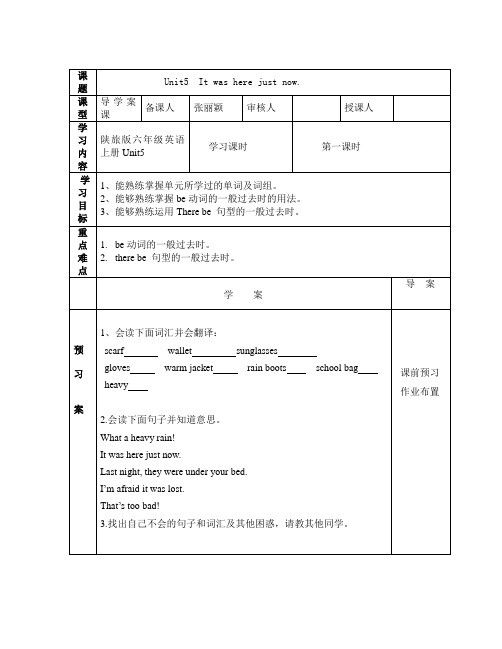
课题Unit5 It was here just now.课型导学案课备课人张丽颖审核人授课人学习内容陕旅版六年级英语上册Unit5学习课时第一课时学习目标1、能熟练掌握单元所学过的单词及词组。
2、能够熟练掌握be动词的一般过去时的用法。
3、能够熟练运用There be 句型的一般过去时。
重点难点1.be动词的一般过去时。
2.there be 句型的一般过去时。
学案导案预习案1、会读下面词汇并会翻译:scarf wallet sunglassesgloves warm jacket rain boots school bagheavy2.会读下面句子并知道意思。
What a heavy rain!It was here just now.Last night, they were under your bed.I’m afraid it was lost.That’s too bad!3.找出自己不会的句子和词汇及其他困惑,请教其他同学。
__________________________________________________________课前预习作业布置学习过程1.检查预习情况,完成Part A部分。
2.翻译短语,师教读短语,大家跟读Let’s learn,熟练掌握本课的重点词汇。
3.学会流利的读课文,小组互读Let’s talk.4.通过小组互助翻译整篇对话。
5.找出本课的知识点讲给自己的同桌。
6.小组共同探讨本课的知识点,派组代表讲解给大家,评出最优小组。
7.把自己找到了困惑说出来,大家帮忙解决。
8.小结自己的收获,学生谈的不全面的老师适当总结补充.结合课前学生预习情况及存在的问题加以点拨。
检测案一、按要求写单词。
1.scarf (复数)2. thousand (复数)3. glove (复数)4.boot (复数)5.heavy (反义词)二、根据提示写单词。
1.There is nothing in the (钱包)2.Lyn has a new (书包)3.It was warm (昨天)。
陕旅版小学六年级上册英语全册教案

陕旅版小学六年级上册英语全册教案教案编号: xxx版本: 陕旅版年级: 六年级上册学科: 英语目标:- 帮助学生掌握六年级上册英语课程的内容- 提供有效的教学方法和策略,以促进学生的研究和发展教学内容:单元一: My School Life- 单词:school, student, teacher, friend, classroom, library- 句型:1. What's your favorite subject? 2. My favorite subject is Math.单元二: The Weather- 单词:weather, sunny, cloudy, rainy, snowy, windy- 句型:1. How's the weather today? 2. It'ssunny/cloudy/rainy/snowy/windy.单元三: Family- 单词:family, father, mother, brother, sister, grandparents- 句型:1. How many people are there in your family? 2. There are four people in my family.单元四: Time and Daily Routines- 单词:time, get up, have breakfast, go to school, do homework, go to bed- 句型:1. What time do you get up? 2. I get up at 7 o'clock.教学方法:- 获取学生的先前知识,根据学生的程度进行教学安排- 使用多媒体资料,如图片、视频、音频等,以增加学生的兴趣和参与度- 运用多种教学活动,如游戏、小组讨论和角色扮演,以提高学生的口语交流能力- 通过课堂练和个人作业来巩固学生的研究内容评估方式:- 写作和口语表达练- 参与课堂讨论和问答- 小组合作项目- 个人作业和考试资源准备:- 课本和练册- 多媒体设备,如电脑、投影仪等- 图片、音频和视频资源- 游戏和角色扮演道具教学时间安排:- 单元一: 2课时- 单元二: 2课时- 单元三: 3课时- 单元四: 3课时教学反馈和调整:- 定期评估学生的研究情况,根据需要调整教学计划- 鼓励学生提出问题和意见,并及时解答和回应- 配合学生家长,共同关注学生的研究进展,在必要时提供额外的辅导和帮助备注:- 教案内容仅供参考,请根据实际情况进行适当的调整和变动- 本教案遵循陕旅版教材要求,但不涉及法律复杂问题。
2021年陕旅版六年级上册Unit5第一课时课件
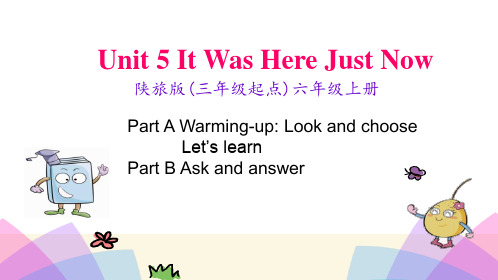
课堂互动 小调查:Who is wearing glasses?
课文原文 How is the weather today?
It’s raining. So I can wear my rain boots.
课文原文
课文原文
What’s this?
It’s Wu Chen’s school bag.
新词展示
点击电视机,跟我一起 学词汇吧!
新词展示
话题导入
Free talk
How is the weather today? 今天天气怎么样?
课文原文 Look and choose
c
b
e
d
课文原文
What kind of weather do you like?
课文原文 Let’s learn
Unit 5 It Was Here Just Now
陕旅版(三年级起点)六年级上册
Part A Warming-up: Look and choose Let’s learn
Part B Ask and answer
课前热身
How is the weather?
It's sunny today.
【carf 一条红色的围巾
课文原文
课文原文
Ask and answer
课堂互动
记忆大比拼
在规定时间内,记忆本课时所学的词汇,看 谁记得多。
巩固练习
回顾小结
本课我们学习了以下知识,请同学们一定加强巩固,以 便能和同学们进行灵活交流哦!
It’s a sunny day. I will wear my sunglasses.
课文原文
重难点探究
六年级英语上册Unit5教案

六年级英语上册Unit5教案六年级英语上册Unit5教案第1课时教案Teaching cntents 教学内容Str tieTeaching ais and learning bectives 教学目标1. 能听懂、会读、会说:Wet flr, N littering, N eating r drining, a restaurant, N sing, shpping centre, sell, careful。
2. 能听懂、会读、会说日常用语:What des it ean? It eans … N littering/paring/sing/ … u can/can’t …。
3. 能正确地理解并朗读对话内容,在教师的'引导和帮助下尝试复述课文内容。
4. 能初步运用本课所学的词汇和日常用语谈论公共场所标志的含义。
Fcus f the lessn and predicted area f difficult 教学重点和难点教学重点:能正确地理解并朗读对话内容,在教师的引导和帮助下复述课文内容。
教学难点:能初步用句型:What des it ean?It eans … (N littering/paring/sing/…) u can/can’t …。
Teaching prcedures 教学过程Step 1 Greeting ≈ War up1. T: Hell, bs and girls.S: Hell, Mr/Miss …T: I’ glad t see u.S: Glad t see u, t.【设计意图:日常问候,过渡课堂。
】Step 2 Pla a gaeT: Bs and girls, let’s pla “true and false”, O?L, if u thin the picture is right, please sa “eah eah eah”, if u thin it’s It’s tie fr lunch.)What des Bbb have fr lunch? (He has se bananas.)Des Bbb have a gd lunch? (N, he desn’t.)【设计意图:带着问题观看动画,学生注意力更集中。
(新版)陕旅版六年级上册全册教案

6.Practice the dialogue.
Step 3 Practice
Game---Chain game
Step 4 Consolidation
1.Make a small survey.
2.Give assessment
课后反思
I was….
3.学习并初步掌握动词be的过去时was,were的形式及用法
知识重点
能听说读写并运用本课的新词并带入所学句型进行对话
知识难点
学习并初步掌握动词be的过去时was,were的形式及用法
教学用具
磁带,单词图片,课件
教学内容
个性化修改
Step 1 Warming up
1.Greetings
听课文录音,圈出生词,试着猜出大概意思.
1句型:a: Where were you yesterday?
b: I was at the museum.
A: Why were you there?
B: Because…
2单词:famous著名的
actor男演员
actress女演员
the other另一个
……
Step 4.使用以上所学新句型,进行简单的口语对话。
Step5.互动释疑
1分角色朗读课文。
2找搭档认读、翻译句子。
Step6.巩固拓展
完成P3的阅读。
Step7.听写练习:1.词汇。2.句子。
课后反思
课题
PartC
课时
第7~8课时
教
学
目
标
1.Grasp the new words, sentences, grammar in the unit
陕旅版六年级英语上册课件Unit 5 Part A(陕旅)

预习“Let’s learn more”。
陕西旅游出版社 六年级 | 上册
Kevin: Thanks, Mom. I have to go now. Oh, where is my bike? It was in front of the house yesterday, but now it isn't there. Mom: I’m afraid it was lost. You have to walk to school today. Kevin: That’s too bad!
陕西旅游出版社 六年级 | 上册
课文讲解—was, were的用法
Wnday. What day is it yesterday? Yesterday was Saturday.
陕西旅游出版社 六年级 | 上册
Where were you at six this morning? I was at home.
b b. snowy
a
e
d
c. rainy
d. windy
e. cloudy
陕西旅游出版社 六年级 | 上册
What kind of weather do you like?
Look, choose and write
陕西旅游出版社 六年级 | 上册
1.The shoes are u_n_d_e_r_the bed. 2.The desk is __b_es_i_d_e _the bed. 3.There is a computer___o_n_the desk. 4.There are some flowers__b_e_h_in_d__the computer. 5.A:Where are the ruler and the pen?
陕旅版六年级上册Unit5教案设计

单元(组)教学计划课时教案课时教案参考答案:1. under 2.beside 3.on 4.behind 5.in 3.最后请学生自己看图说句子。
Ⅱ.教学设计 ⅰ新课程展示T: Hello, everyone. We should wear different kind of clothes there is different weather, It israiny today, Kevin wants to wear his raincoat. Let ’s listen carefully.1.教师就本段对话提出问题,然后播放录音,让学生在对话中找到答案。
Question1: Where is Kevin ’s raincoat? Question2: Where are Kevin ’s rain boots?2.教师请学生来回答问题,检测他们对对话的理解,然后引导学生看句子说出问题的答案。
Answer1: Kevin ’s raincoat is behind the door. Answer2: Kevin ’s rain boots are behind the bed. ⅱ.阅读理解1.教师提出问题,让学生读对话,判断句子正误并改正错误的句子。
Kevin ’s bike is in frond of the house now. Kevin ’s will go to school by bike today. 2.教师请学生说出正确答案。
ening, just now, last week/year/month/nigh t …,…ago, at six this morning (在说话时间之前)等,随着对过去时态深入的学习,教师可逐步向学生介绍。
知识小贴士(二)Have to do something 用来表达“不得不做某事”,可在日常生活中表示某人因环境或条件所限,不得已而做出的选择。
陕旅版六年级上册英语Unit 5 It Was Here Just Now 第三课时教案(新审定)

第三课时教学目标1. 能听懂和理解Let’s learn more部分的两个对话。
2. 学习和掌握be动词过去式的否定形式(wasn’t, weren’t)、疑问形式及一般过去时在there be结构中的应用。
3. 通过对对话的学习,能对事物的今昔进行对比表达。
教学准备教师准备:Let’s learn more部分的录音磁带、录音机。
教学方法建议Ⅰ. 课程导入(Leading In)ⅰ. 课前热身教师让学生说唱Part B Let’s chant部分进行热身,可采用男女生一问一答或分组一问一答的形式进行。
Where were you yesterday?I was in my house.Where was your house yesterday?It was on my back.ⅱ. 新课导入T: Hello, everyone. Do you love our school?Ss: Yes.T: Can you say something about our school?Ss: Our school is beautiful. There are many students here.Ⅱ. 课程展示活动和过程的设计建议(Presentation)ⅰ. 新课展示 Part B Let’s learn more教师可先让学生通过听录音了解对话大意,引出功能句。
T: Well. Liu Zhaoyang’s dad is visiting his old school.Are there any differences? Let’s listen carefully.1. 教师就本段对话提出问题。
Question 1: When was Liu’s dad at this school?Question 2: Was there a library?Question 3: How many students were there at that time?2. 教师播放录音,学生在对话中找答案。
小学英语陕旅版六年级上册Unit 5 It was here just now《PartA》优质课教案获奖教案公开课教师面试试讲教案
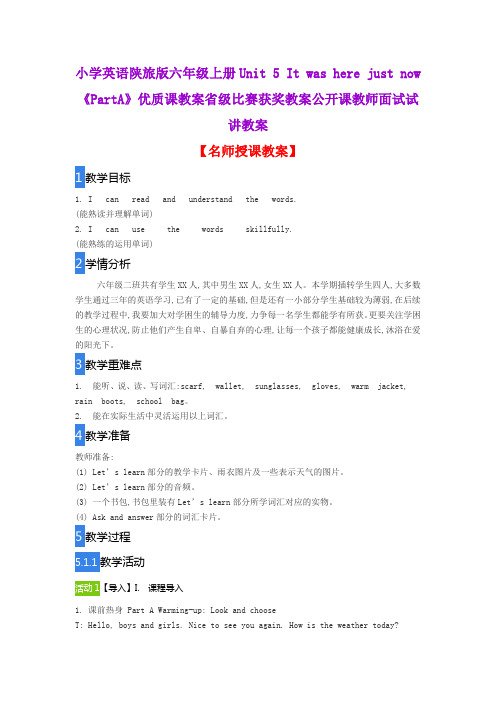
小学英语陕旅版六年级上册Unit 5 It was here just now 《PartA》优质课教案省级比赛获奖教案公开课教师面试试讲教案【名师授课教案】1教学目标1. I can read and understand the words.(能熟读并理解单词)2. I can use the words skillfully.(能熟练的运用单词)2学情分析六年级二班共有学生XX人,其中男生XX人,女生XX人。
本学期插转学生四人,大多数学生通过三年的英语学习,已有了一定的基础,但是还有一小部分学生基础较为薄弱,在后续的教学过程中,我要加大对学困生的辅导力度,力争每一名学生都能学有所获。
更要关注学困生的心理状况,防止他们产生自卑、自暴自弃的心理,让每一个孩子都能健康成长,沐浴在爱的阳光下。
3教学重难点1. 能听、说、读、写词汇:scarf, wallet, sunglasses, gloves, warm jacket, rain boots, school bag。
2. 能在实际生活中灵活运用以上词汇。
4教学准备教师准备:(1) Let’s learn部分的教学卡片、雨衣图片及一些表示天气的图片。
(2) Let’s learn部分的音频。
(3) 一个书包,书包里装有Let’s learn部分所学词汇对应的实物。
(4) Ask and answer部分的词汇卡片。
5教学过程教学活动1【导入】I. 课程导入1. 课前热身 Part A Warming-up: Look and chooseT: Hello, boys and girls. Nice to see you again. How is the weather today?。
20秋陕旅版英语六年级上册陕旅六上 Unit 5 第三课时
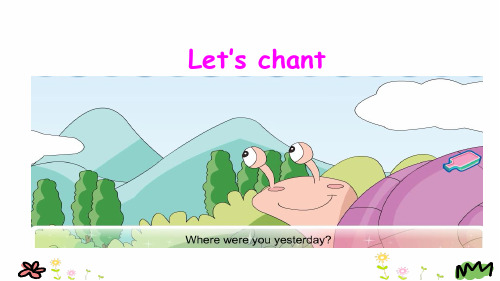
are
Were was
Is
are am
were was
英汉互译。
1. just now 3. in front of
2. 昨天晚上 4. 棉夹克
5. two thousand
6. 十年以前
答案: 1. 刚才 2. last night 3. 在……前面
4. warm jacket 5. 两千
6. ten years ago
Let’s chant
Free talk
Do you love our school?
Can you say something about our school?
Liu Zhaoyang’s dad is visiting his old school. Are there any differences? Let’s listen carefully.
否定回答: No, 主语 + be动词过去式否定形式(wasn't/weren't).
Was he in the bookshop last night?昨晚他在书店吗?
Yes, he was. 是的, 他 在。
No, I wasn’t. 不, 我不在。
做一做,说一说
Thirty years ago
It was a s__m__a_lsl chool. There were_s_i_x__h_u__n_d__r_e_d__s_t_u_d__e_n_.ts There was a___l_i_b_r_a_r_y_. There___w__a__s_n_’_t_ a computer room.
Now
It is a _b__ig_school. There are about _t_w__o__th__o_u__s_a_n__dstudents. There is_a__l_ib__r_a_r_y_,_t_o_o_. There__is___ a computer room.
六年级英语上册 Lesson 5(1)教案 陕旅版
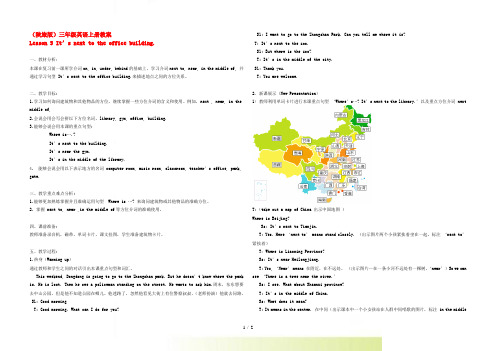
(陕旅版)三年级英语上册教案Lesson 5 It’s next to the office building.一、教材分析:本课在复习前一课所学介词on, in, under, behind的基础上,学习介词next to, near, in the middle of, 并通过学习句型 It’s next to the office building.来描述地点之间的方位关系。
二、教学目标:1.学习如何询问建筑物和其他物品的方位,继续掌握一些方位介词的含义和使用。
例如,next , near, in the middle of,2.会说会用会写会拼以下方位名词,library, gym, office, building.3.能够会说会用本课的重点句型:Where is….?It’s next to the building.It’s near the gym.It’s in the middle of the library.4. 能够会说会用以下表示地方的名词 computer room, music room, classroom, teacher’s office, park, gate.三、教学重点难点分析:1.能够更加熟练掌握并且准确运用句型 Where is …? 来询问建筑物或其他物品的准确方位。
2. 掌握 next to, near ,in the middle of等方位介词的准确使用。
四、课前准备:教师准备录音机,磁带,单词卡片,课文挂图,学生准备建筑物卡片。
五、教学过程:1.热身(Warming up)通过教师和学生之间的对话引出本课重点句型和词汇。
This weekend, Dongdong is going to go to the Zhongshan park. But he doesn’t know where the park is. He is lost. Then he see a policeman standing on the street. He wants to ask him.周末,东东想要去中山公园。
陕西省旅游出版社六年级上册英语第5课教案 (1)

高效课堂导学案课题Lesson 5 It's next to the officebuilding年级学科六年级英语课型预习+展示课时第一课时主备人李转利学习内容Excuse me,where is the library?/ It's next to the gym.学习目标1: Listening and speaking: Excuse me,where is the library?/ It's next to the gym./ But where is the gym?/ It's over there,near the office building. /It's in the middle of the school./Thank you./You are welcome.2: Words :buildings a library a gymin the middle of重难点本课的重点学习询问地点以及人物的位置方向。
本课的难点是引导学生学会描述方位,会用方位介词单描述出某人或某物的比较具体的方位。
突破重点和难点的关键是让学生多加练习,鼓励学生在日常生活的过程中多运用英语表达方位,一般简单的口语要求学生用英语表达。
创造一个良好的学习英语的氛围。
课前准备:1. Word cards.2. Radio and tape.3. The picture of building,library.学习过程环节学案导案1.Warm- upa. Sing the song“Where is Mimi?"b. T and Ss greeting each other.c. Act out the dialogue of “Listen and read”, Lesson 5.2.Presentation:练习“Where is…?”句型,多次练习使学生能够理解“Where is…?”,将一些工具、教具之类的辅助材料放在讲桌上,让学生根据老师的命令找出相应的实物,老师通过多次询问“…在哪里?”,帮助学生熟悉和学习句型“Where is…?”T:Where is my book?Ss: It's on the desk..T:Where is my ruler?.Ss: It's in the box.T: Where is my pencil?.Ss: It's under the chair.T: Where is my picture?.Ss: It's under the desk.New teaching .1). buildings拿出一张画有高楼大厦的图片,向学生询问:“What is it?”[小精灵儿童网站]先让学生辨认图片,启发学生回答,在关键时刻告诉学生高楼大厦的英语用“buildings”来表示,引导学生朗读、拼写单词,直到会读、会写为止。
- 1、下载文档前请自行甄别文档内容的完整性,平台不提供额外的编辑、内容补充、找答案等附加服务。
- 2、"仅部分预览"的文档,不可在线预览部分如存在完整性等问题,可反馈申请退款(可完整预览的文档不适用该条件!)。
- 3、如文档侵犯您的权益,请联系客服反馈,我们会尽快为您处理(人工客服工作时间:9:00-18:30)。
单元(组)教学计划课时教案it’s very hot Now ,look! I’m wearing my T-shirt. Do you feel hot.S1?S1…II 授新课:i.新课展示Part A Let’s learn1.学习单词sunglasses(1).教师戴上自己的太阳镜,与学生进行通话:T: It’s a sunny day .I am wearing my sunglasses. Look! They are dark.Think I am very cool. But do I need to wear them in the classroom?Ss: NoT: I have bad eye sight I should wear glasses.I have a pair of glassesWhat color are they?Ss: They are blue /red …(2).小调查:Who is wearing glasses?教师请学生就班里戴眼镜的同学进行调查。
T: Who is wearing glasses?S1: …is wearing glasses.S2:….is wearing a pair of green glasses.S3:…is wearing a pair of green glasses.T: Yes. They wear glasses. But they are not sunglasses. Sunglasses are usually dark. (3).教师板书、学生分组读单词,教师注意纠正学生的错误读音。
2.学习词组rain boots教师出示雨天的图片,与学生进行对话:T: We can wear our sunglasses on a sunny day. Look. It is raining . What can we take with us ? S: We can take our umbrellas.T: And we can wear our raincoats. (教师出示雨衣照片) Sometimes. Rain cats and dogs (教师出示倾盆大雨图),and my shoes are wet.I can wear my rain boots. (教师出示雨靴图片) 教师板书、学生分组读词组,并注意Boots中字母组合OO的读音。
Boots 中字母组合OO读长音(u:). 在单词boots ,school中都有OO,并且都读长音(u:)3.学习词汇School bag. Wallet .scarf, gloves, warm jacket教师出示所准备的书包。
与学生进行对话;T: Look at this bag . It’s my school bag. I have something in my bag.Can you guess what’s in it? (教师请一名学生摸包里的物品)What do I have?S1:You have a “钱包 and 手套T: Well. I have a wallet and a pair of gloves. Where are they?Ss: They are in your school bag.教师请学生打开钱包,说出钱包中的物品。
T: Open the wallet and tell me what you can see in it?Ss: I can see some money.Yes. Winter is coming. We should wear our warm clothes I will buynew clothes for me with the money. Do you know what I will buy?T/Ss: A scarf , gloves and a warm jacket.(教师引导学生说出)教师逐一出示围巾、手套和棉夹克的图卡和词卡、板书并引导学生学习生词。
ⅱ. 巩固活动教师播放此部分的录音,让学生听录音跟读词课时教案参考答案:1. under 2.beside 3.on 4.behind 5.in 3.最后请学生自己看图说句子。
Ⅱ.教学设计 ⅰ新课程展示T: Hello, everyone. We should wear different kind of clothes there is different weather, It israiny today, Kevin wants to wear his raincoat. Let ’s listen carefully.1.教师就本段对话提出问题,然后播放录音,让学生在对话中找到答案。
Question1: Where is Kevin ’s raincoat? Question2: Where are Kevin ’s rain boots?2.教师请学生来回答问题,检测他们对对话的理解,然后引导学生看句子说出问题的答案。
Answer1: Kevin ’s raincoat is behind the door. Answer2: Kevin ’s rain boots are behind the bed. ⅱ.阅读理解1.教师提出问题,让学生读对话,判断句子正误并改正错误的句子。
Kevin ’s bike is in frond of the house now. Kevin ’s will go to school by bike today. 2.教师请学生说出正确答案。
ening, just now, last week/year/month/nigh t …,…ago, at six this morning (在说话时间之前)等,随着对过去时态深入的学习,教师可逐步向学生介绍。
知识小贴士(二)Have to do something 用来表达“不得不做某事”,可在日常生活中表示某人因环境或条件所限,不得已而做出的选择。
如:It ’s late. We have to go fast. It ’s raining. I haveto wear my raincoat. Rose has to take a bus to the park, because it ’s a little far from here.改为:Kevin’s bike was in frond of the house yesterday.Kevin’s will walk to school. / Kevin’s will go to school on foot.3.教师讲解was、were的用法:教师用今天和昨天,通过星期名称引出yesterday、today及后面的were,教师与学生进行如下对话:T:what day is it today?(以当天为Tuesday,以此为例)S: It’s Tuesday.T: You are right. Today is Tuesday。
(问前一天)What about yesterday?S:(引导学生说出)Yesterday was Monday.T: Where are you now?S: I’m in the classroom now.T: Where were you at six this morning?S: I was at home.(教师引导学生说出句子)T:We are in classroom now. And I’m here with you now. But I was not here just now. I was in the teachers’ office just now.教师板书句子,用红色粉笔标出句子的动词及时间状语。
It’s …today. It was …yesterday.I’m in the classroom now. I was in the teacher office just now.You are in the classroom now. You were at six this morning.4.找出Let’s talk部分中含有was,were的句子并板书,朗读:It was here just now.Last night, they were under your bed.It was in front of the house yesterday.I’m afraid it was lost.5.让学生朗读课文并画出对话中I have to go now, You have to walk to school ……today两句话。
教师板书并领读这两个句子,继而做一些讲解使学生理解somebody have to do something结构说话。
ⅲ.巩固活动听录音,让学生跟读Let’s talk 部分的对话,教师注意纠正学生发音。
Ⅲ教学设计Part B Let’s chant1.教师可先让学生试读课文并画出句子中的动词及课时教案教学流程二次备课Ⅰ.导入ⅰ.课前热身教师让学生说唱Part B Let’s chant部分进行热身,可采用男女生一问一答或分组一问一答的形式进行。
Where were you yesterday?I was in my house.Where was your house yesterday?It was on my back.ⅱ.新课导入T: Hello, everyone. Do you love our school? S: Yes.T: Can you say something about our school?S: Our school is beautiful. There are many students here.Ⅱ.教学设计ⅰ.新课展示Part B Let’s learn more1.教师可让学生通过听录音了解对话大意,引出功能句.T: Well .Liu Zhao yang’s dad is visiting his old school. Are there many differences? Let’s listen carefully. 可数名词单数或不可数名词时,be动词用was, be动词后的名词是可数名词复数是Be动词用were; 疑问句需要把was/were提到主语之前,否定句was/were后面加not.否定形式可缩写为wasn’t /weren’t知识小贴士There be 结构的过去式表示某处过去曾经有某物,be 动词后的名词数名词单数或不可数名词时,be 动词用was ,be 动词后的名词是可数名词复数时,Be动词用 were ; 疑问句需要把was/were 提a)教师就本段对话提出问题。
